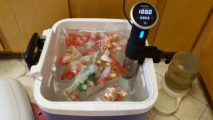Sous vide equipment is an easy and cheap way to do small scale HWT at home. No need for elaborate controllers or pumps or adding heated water – one little device has thermometer, controller, and circulating pump. I bought the cheapest one available ($136 all told) and it provides excellent control from 100F on up. Well worth checking into if you haven’t already discovered this.


This is good to know! Thanks for sharing, Kathleen.
Hi, Kathleen! This is excellent news! Can you provide a link to this so I can get the model number and stuff? I definitely want to HWT next year!
Thanks!
Suzy
They are on sale also in the UK, Lakeland sell them.
Hi Kathleen,
When one provides good news I feel bad at being a prat. The HWT system looks superb. When I first started HWT I used an old wringer washing machine bowl with an electric jug element fitted into the drainage hole. Great until visitors arrived and I forgot to maintain the temperature. Alf Chappell lost 20 years of seedlings doing a similar thing. Your system looks fool proof. However I am really concerned at the bulbs being stored in plastic bags. This seems to be a real no no to me.
Dave
Dave – I use a (fairly strong) bleach solution for HWT and didn’t want to expose the pump to it. I’m pretty sure it had plastic parts. So I put the bulbs (in their mesh storage bags) into zip look bags, one for each variety. I then put in a cup or two of 10% chlorox, do a water immersion to get all the air out, and put the zip locked bulbs in the water bath. They do tend to get more air bubbles during the process which keeps them floating. I think this is ok as long as the bulbs are completely immersed in their baths. I was following a 3 hrs 100F, 3 hrs 116F recipe. I SWAGed it and allowed an extra 1/2 hour at 100F to allow for the extra heat transfer resistance of the zip lock bags and the unagitated water inside them. It took about 45 min for my large reservoir to heat from 100 to 116F and, since I had left the bulbs in the bath, I did not add any time to the higher temp.
This would all be simpler if I were willing to expose the unit to bleach – maybe next year, esp if I can get hold of a technical support type at Anova who can tell me what the pump is made of. Possibly this would be unnecessary for people who use formalin rather than bleach, but I don’t know anything about the effects of formalin on plastic.
Suzy – I bought an Anova unit, based strictly on cost. It’s easy to set and has plenty of oomph. I used too big and too deep a cooler as the bath and was impressed by how uniform the temperature was within the bath. There’s lots of varieties out there – the magic words are “sous vide.”
I then ask the question ‘ Why add beach or formalin to the water?’ I am a little confused on this and would like an expert once again to convince me as to why the additives are necessary.
Dave
Dave – I will have to refer you to Ted Snazelle, whose “Daffodil Diseases and Pests” recommends 0.5 vol % formalin. “The use of o.5% formalin in the pre-load is important as the formalin will kill any nematodes which become activate from the nematode wool state by the soak. Additionally, the formalin will kill spores of the basal rot fungus. Thus, HWT without formalin will never be as effective as HWT with formalin.”
I don’t have formalin on hand and so used bleach at a concentration that was successfully used by other growers. I am under the impression that the formalin or bleach will prevent any transmission of virus from bulb to bulb, via the water.
Thanks Kathleen,
I will take Ted’s greater knowledge as a good guide even if I don’t personally follow the advice maybe to my detriment.
Dave
Kathleen, I wonder if you need bleach if the bulbs are contained within the plastic bags. The virus would be kept within the bag, wouldn’t it? It will be interesting to see how the bulbs do next spring.
Mary Lou
MaryLou – I wondered about that also, but decided better safe than sorry. Next year will certainly be the test. I have them in a nice little bed of their own.